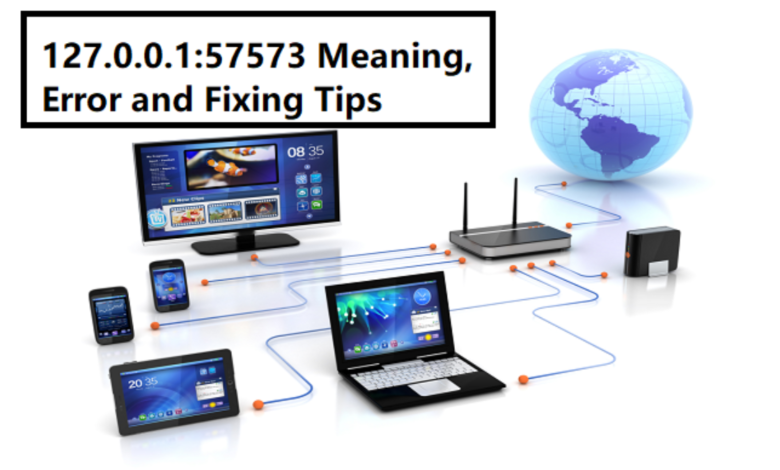Understanding 127.0.0.1:57573: A Comprehensive Guide to Localhost Connections

When you’re navigating the world of computers and the internet, you’ve probably encountered the term “127.0.0.1:57573.” But what exactly does it mean, and why should you care? In this article, we’ll break down what “127.0.0.1:57573” refers to, how it works, and its significance in networking, especially for developers and tech enthusiasts.
What is 127.0.0.1:57573?

To fully grasp the meaning of “127.0.0.1:57573,” we need to understand two key components: the IP address “127.0.0.1” and the port number “57573.”
127.0.0.1: The Localhost Address
“127.0.0.1” is commonly known as the “localhost” or “loopback” address. It is a special IP address that always points to your computer or device. Essentially, when you use “127.0.0.1,” you’re referring to the machine you’re currently using, without connecting to the outside world.
In a typical scenario, when your computer accesses the internet or communicates with other devices, it uses unique IP addresses assigned by your network. However, “127.0.0.1” is reserved for internal communication within your device.
Port Number 57573: A Gateway for Communication
The “:57573” portion of “127.0.0.1:57573” refers to a specific port number. Port numbers are like doors on your computer through which data enters and exits. Every service running on your computer that communicates over a network uses a specific port. The port number helps direct the traffic to the right service.
In this case, “57573” is a randomly assigned port number, and it could be used by a specific application or process running on your system. This means that any data sent to “127.0.0.1:57573” is directed internally to your computer, specifically to the service or application that listens on that port.
Why Does 127.0.0.1:57573 Matter?
Understanding “127.0.0.1:57573” is crucial for several reasons. This local connection is commonly used by developers, system administrators, and tech professionals to troubleshoot, test applications, and manage networks. Let’s dive into a few scenarios where this address and port are important.
Web Development and Testing
For web developers, “127.0.0.1” is often used to host a local server for testing websites and web applications. By using this IP address, developers can test how a website behaves in a real environment without exposing it to the public internet.
For example, if a developer runs a local web server on their machine, they might access the site by entering “127.0.0.1:57573” in their browser. The port “57573” ensures the data is sent to the correct server application running on the developer’s computer.
Network Troubleshooting
“127.0.0.1” is also essential for troubleshooting network issues. If you’re experiencing problems connecting to a server or website, you can test if your computer’s networking stack is functioning properly by trying to ping “127.0.0.1.” This tests whether your computer can communicate with itself over the network.
If there’s an issue with the localhost, it’s likely a problem with the device’s network configuration or software. On the other hand, if “127.0.0.1” is working but you’re unable to connect to external sites, the issue is probably with your network connection.
Security Testing and Penetration Testing
Security professionals often use “127.0.0.1” for security testing. Localhost connections allow them to test for vulnerabilities and potential security flaws in their applications or systems without exposing sensitive information to the internet. This ensures that they can fix issues before launching a service publicly.
How to Use 127.0.0.1:57573 in Practice
So, now you know what “127.0.0.1:57573” means, but how do you use it in real-world scenarios? Let’s explore some practical applications of this address and port number.
Setting Up a Local Web Server
If you’re a web developer, you may want to run a local server on your machine to test websites or web applications before going live. Here’s how you can set up a local server that listens to “127.0.0.1:57573”:
- Install Server Software: You can use popular software like XAMPP, WAMP, or Python’s built-in HTTP server to set up your local server.
- Configure the Port: Choose the port number you want your server to listen to. In this case, you can set the server to listen on port “57573.”
- Access the Server: Once the server is running, open a web browser and type “127.0.0.1:57573” in the address bar to see your local site in action.
Running a Local Application
If you are running a local application that communicates over the network (such as a database, API, or game server), it might use “127.0.0.1” as its host address and a specific port like “57573” for communication.
For instance:
- Local API: If you’re building an API for a project, you might configure it to run on “127.0.0.1:57573.” Any client that interacts with this API will send requests to the localhost at this port.
- Database Connection: Many database management systems use “127.0.0.1” for local connections, ensuring that applications on your machine can interact with the database without the need for an external network.
Network Diagnostics
When troubleshooting network issues, running tests using “127.0.0.1” is a quick way to ensure your computer’s networking system is working. For example:
- Ping the Localhost: Open the command line or terminal and type:
- Copy code
- ping 127.0.0.1
- This will check if your network stack is functioning correctly.
- Check Open Ports: To see which services are listening on specific ports, you can use tools like Netstat or lsof to examine open connections and ports on your system.
Common Issues with 127.0.0.1:57573
Although “127.0.0.1:57573” is generally reliable, there are some common issues that might arise when working with it.
Port Conflicts
If another service is already using port “57573” on your system, trying to bind a new service to that port can result in a conflict. This can cause the application to fail to start. To avoid this:
- Choose a different port number.
- Use tools like Netstat to check which ports are in use.
Firewall Blocking
Sometimes, a firewall on your computer or network might block traffic to or from “127.0.0.1:57573.” This can prevent applications from communicating locally. To resolve this, you may need to adjust firewall settings to allow traffic on this port.
Misconfigured Server
If you’re hosting a local server and you can’t access “127.0.0.1:57573,” it’s possible that the server is misconfigured or not running. Double-check your server software settings and ensure that the service is active.
Advanced Uses of 127.0.0.1:57573
As you become more familiar with using “127.0.0.1:57573,” you may find advanced uses for it, such as:
- Virtualization: Running virtual machines on your computer often involves using “127.0.0.1” for network configurations between your host system and virtual machines.
- Proxy Servers: A proxy server can be set up to use “127.0.0.1” as its address, allowing you to route internet traffic through your machine for various purposes, such as testing or anonymizing connections.
Conclusion: The Importance of 127.0.0.1:57573 in Networking and Development
In conclusion, “127.0.0.1:57573” may seem like a simple address and port number, but it plays a crucial role in networking, development, and troubleshooting. Whether you’re testing a website locally, troubleshooting network issues, or setting up a server, understanding this concept will help you navigate many technical challenges.
As you explore the world of local connections and networking, remember that “127.0.0.1” is your gateway to testing and development without the need for external servers. And with port numbers like “57573,” you have the flexibility to direct traffic exactly where it needs to go within your machine.
So, the next time you see “127.0.0.1:57573,” you’ll know exactly what it means and how to use it to your advantage. Happy coding, troubleshooting, and exploring the world of networking!




